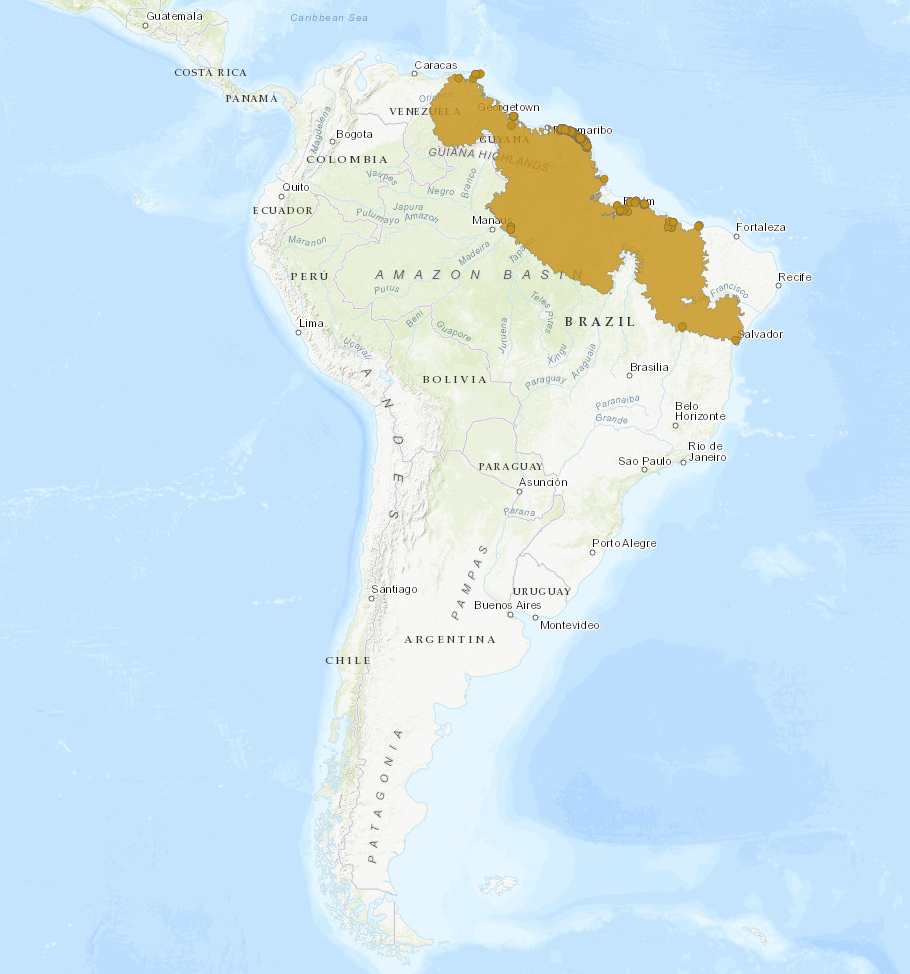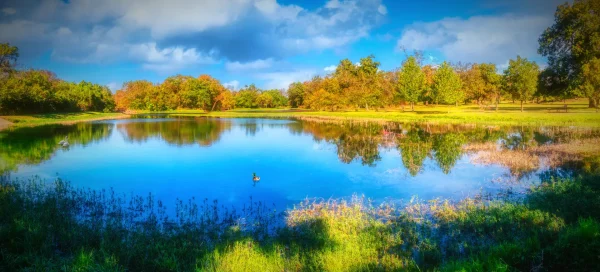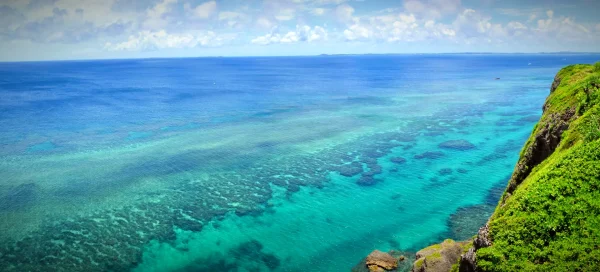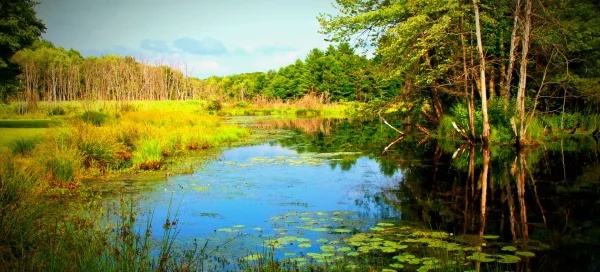Overview
The Largescale Four-eyes, scientifically named Anableps anableps, stands out in the aquatic world due to its remarkable bifocal vision, enabling it to monitor predators and prey in both aerial and aquatic environments simultaneously. Found in the freshwater and brackish waters of northern South America and Central America, this species showcases a significant adaptation to its diverse habitat. Its unique eye structure, divided by a horizontal band of tissue, equips it with the extraordinary ability to navigate and feed effectively at the water’s surface, where the distinction between the submerged and aerial worlds blurs.
Adapting to the varying salinity levels of their estuarine habitats, Largescale Four-eyes exhibit remarkable osmoregulatory capabilities, allowing them to maintain internal balance amidst environmental changes. This adaptation is crucial for their survival in environments where the mixture of freshwater and seawater presents a constant challenge. Moreover, their diet consists mainly of insects, small crustaceans, and algae, making them opportunistic feeders that play a vital role in the aquatic food web. Their surface-dwelling nature and dietary habits contribute to their unique niche within their ecosystem.
The reproductive strategy of the Largescale Four-eyes is another fascinating aspect of their biology. As viviparous creatures, they give birth to live, fully developed offspring, bypassing the egg stage and increasing the chances of juvenile survival in the wild. This characteristic, coupled with their intriguing vision, makes them not only subjects of scientific curiosity but also sought-after specimens for aquarists capable of replicating their natural habitat in captivity. Their overall biological and ecological traits underscore the complexity of adaptation and survival strategies among fish, highlighting the diversity of life forms in aquatic ecosystems.
Taxonomy
Kingdom
Phylum
Class
Order
Family
Genus
Species
Type
RANGE
Current distribution:
Largescale Four-eyes are distributed throughout the coastal regions of northern South America, including Venezuela, Guyana, Suriname, and parts of Brazil, as well as in the waters of Central America. While not listed as endangered, their populations are vulnerable to environmental changes and habitat destruction. Efforts to monitor and protect their natural habitats are essential for their conservation.
In addition to their presence in the wild, Largescale Four-eyes are occasionally found in the aquarium trade, where their unique appearance and behavior make them a novelty. However, their specific care requirements and need for a brackish water setup limit their suitability for casual aquarists.
Physical Description:
Largescale Four-eyes are easily recognizable by their unusual eyes, each split horizontally into two parts by a band of tissue. This adaptation allows them to see both above and below the water surface simultaneously, a useful trait for spotting predators and prey. Their bodies are elongated and somewhat flattened laterally, facilitating their surface-dwelling lifestyle. The dorsal and anal fins are positioned far back on the body, near the caudal fin, which aids in their swift movement across the water’s surface.
The coloration of Largescale Four-eyes ranges from olive to dark brown on the dorsal side, with a lighter underside, providing camouflage against both aerial and aquatic predators. Males and females can be distinguished by the presence of an enlarged, modified anal fin in males, used during internal fertilization. This sexual dimorphism is common among live-bearing fish species.

Lifespan: Wild: ~5 Years || Captivity: ~6 Years

Weight: Male & Female: 12-14 oz (340-400 g)

Length: Male & Female: 10-12 in (25-30 cm)
Characteristic:
Native Habitat:
The Largescale Four-eyes is native to the coastal regions of northern South America and parts of Central America, where it inhabits brackish waters of estuaries, mangroves, and the lower stretches of rivers. These habitats provide the mix of fresh and saltwater essential for this species’ osmoregulation. The fluctuating salinity, abundant vegetation, and availability of small prey in these environments are ideal for the survival and reproduction of Largescale Four-eyes.
Conservation of their natural habitats is important for maintaining the populations of this unique species, as these areas are often threatened by pollution, habitat destruction, and changes in water salinity due to human activity.
Biomes:
WWF Biomes:
Biogeographical Realms:
Continents:
Diet:
Diet & Feeding Habits:
Largescale Four-eyes are omnivorous, with a diet that includes algae, insects, and small crustaceans. This diverse diet supports their health and growth in wild and captive environments. They are surface feeders, often seen skimming the water’s surface to catch prey or graze on floating vegetation. In captivity, their diet can be supplemented with various foods, including flake food, small live or frozen prey, and vegetable matter, to ensure a balanced intake of nutrients.
Feeding Largescale Four-eyes in an aquarium setting requires attention to their natural feeding behavior, providing food that floats or remains near the surface to accommodate their unique vision and feeding strategy. Regular feeding schedules and varied diets help mimic their natural feeding habits and maintain their health.
Mating Behavior:
Mating Description:
Largescale Four-eyes are viviparous, meaning they give birth to live, fully developed young rather than laying eggs. This reproductive strategy involves internal fertilization, with males using their modified anal fin to transfer sperm to the female. Females can give birth to dozens of young at a time, which are relatively large and well-developed, increasing their chances of survival.
Environmental factors such as water temperature and salinity can influence the reproductive cycle of large-scale four-eyes. Replicating these conditions in captivity can be challenging, making breeding less common outside specialized settings or research facilities. Understanding their reproductive habits is important for their conservation, and aquarists are interested in breeding them.
Reproduction Season:
Birth Type:
Pregnancy Duration:
Female Name:
Male Name:
Baby Name:
Social Structure Description:
Largescale Four-eyes are inherently social creatures. They are frequently observed forming loose schools or groups in their natural habitats, particularly during their juvenile stages. This grouping behavior serves as a critical survival mechanism, offering enhanced protection against potential predators and improving their efficiency in locating food sources. The collective movement within these schools can also confuse predators, reducing the likelihood of any single fish being targeted, and the shared information among group members can lead to more successful foraging efforts.
In the controlled environment of an aquarium, mimicking the Largescale Four-eyes’ natural propensity for schooling is essential for their psychological and physical health. Keeping them in groups allows these fish to exhibit their innate social behaviors, significantly reducing stress levels and promoting a more active and engaged lifestyle. This social replication contributes to their well-being and leads to a more dynamic and interesting display for aquarists, showcasing the natural behavior and interaction of Largescale Four-eyes in a way that solitary confinement never could.
Groups:
Conservation Status:
Population Trend:
While the Largescale Four-eyes is not currently listed as endangered, the species faces significant challenges that could threaten its future survival. Environmental changes, including alterations to their freshwater and brackish water habitats, seriously threaten their well-being. Additionally, pollution from industrial waste and agricultural runoff can degrade water quality in estuaries and mangroves, directly impacting the health and reproduction of these unique fish.
In response to these challenges, conservation efforts are increasingly focusing on protecting and restoring estuarine and mangrove habitats, which are vital for the Largescale Four-eyes. Protecting these areas helps maintain the delicate balance of the ecosystems these fish depend on for feeding and breeding. Furthermore, promoting sustainable practices within the aquarium trade is crucial to minimize the impact on wild populations, ensuring that enthusiasts can enjoy these remarkable creatures without contributing to their natural decline.
Population Threats:
The primary threats to Largescale Four-eyes stem from an array of human activities that have increasingly encroached upon their natural habitats. Coastal development for residential, industrial, and recreational purposes has led to significant habitat destruction, leaving these unique fish with fewer places to live, feed, and reproduce. Additionally, pollution from agricultural runoff and industrial waste introduces harmful substances into the water, negatively affecting the health of Largescale Four-eyes and the availability of their food sources.
Efforts to protect the natural habitats of Largescale Four-eyes are essential for the survival of this species and the overall health of the ecosystems they are part of. By maintaining and restoring estuaries and mangrove forests, conservationists can help ensure that the water remains clean and the ecosystems vibrant. Such actions require cooperation from local communities, governments, and industries to implement sustainable practices that reduce pollution and prevent further habitat destruction, safeguarding these critical environments for future generations.
Conservation Efforts:
Conservation efforts for the Largescale Four-eyes are multifaceted, addressing the various threats that jeopardize their existence and the ecosystems they inhabit. Habitat protection and restoration initiatives are at the forefront of these efforts, aiming to safeguard and rehabilitate the estuarine and mangrove environments critical to their survival. Additionally, research into the ecology and biology of the Largescale Four-eyes is vital, providing essential insights that guide conservation strategies and enhance our understanding of their needs and behaviors.
Promoting sustainable practices within the aquarium trade is another key component of conservation efforts for the Largescale Four-eyes. By establishing protected areas, efforts are made to shield these habitats from the impacts of human activity, ensuring the species has sanctuaries where it can thrive. Reducing pollution through better agricultural and industrial practices and rigorous monitoring of water quality are crucial steps to mitigate the adverse effects on their habitats. Together, these actions contribute to preserving the Largescale Four-eyes, ensuring that future generations can witness the beauty and uniqueness of this species.
Additional Resources:
Fun Facts
- The Largescale Four-eyes has uniquely evolved eyes that are divided horizontally, allowing them to see both above and below the water surface simultaneously.
- This fish can survive in freshwater and brackish environments, a testament to its incredible adaptability and complex osmoregulatory system.
- Unlike many fish species, the Largescale Four-eyes gives birth to live young instead of laying eggs, a characteristic known as viviparity.
- Their social nature often leads them to form schools, particularly when young, which is a defense mechanism against predators and enhances their foraging efficiency.
- The species is named for its large, conspicuous eyes, among the most distinguishing features of any fish inhabiting similar ecosystems.
- Largescale Four-eyes are found in the coastal regions of northern South America and parts of Central America, thriving in estuaries and mangrove forests.
- In addition to their unique vision, these fish are known for their swift movements across the water’s surface, often skimming for food or evading threats.
- They are an important part of the aquatic ecosystem, serving as predators of smaller organisms and prey for larger aquatic and terrestrial animals.
- The ability of the Largescale Four-eyes to “walk” on water using their pectoral fins is another fascinating aspect of their behavior, showcasing their adaptability.
- Conservation efforts for the Largescale Four-eyes focus on habitat protection and sustainable aquarium trade practices to ensure the species’ survival and well-being.









